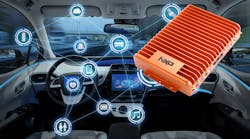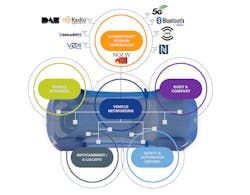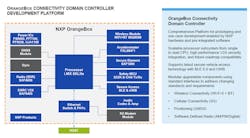What you'll learn:
- What wireless technologies are integrated into the OrangeBox?
- How does streamlining all of these technologies into a single "connectivity domain controller" improve security?
- Details on the other color-coded platforms in the family.
Today, the modern car is more connected than ever, taking advantage of a wide range of wired and wireless technologies to keep it connected to the cloud, smartphones, and even to other cars driving down the road.
To drive the car’s digital transformation, NXP rolled out a new software development platform called OrangeBox. It integrates a wide range of wireless technologies including Wi-Fi 6, Bluetooth, broadcast radio, ultra-wideband (UWB), and dedicated short-range communications (DSRC) for V2X into a single control unit. It also brings GPS for real-time navigation and 4G/5G for telematics (and other purposes) into the package.
Largely but not exclusively based on NXP hardware and software, OrangeBox is a platform in the sense that it aims to make it as easy as possible to prototype new services and apps powered by wireless connectivity.
But more than that, it’s a reference design for what the company calls a connectivity domain controller (CDC). By integrating everything in a single controller, it gives cars a more secure way to communicate with the world around them.
“What we are doing with the new concept is putting all of the wireless connectivity in the car into a single place, using a single powerful processor to manage it all,” said Jim Bridgewater, head of global product marketing for NXP’s automotive processing product line.
New-Age Architecture
As wireless connectivity becomes a bigger focus for automakers, so has the hardware under the hood.
Today, more than 100 electronic control units (ECUs) are distributed throughout a modern car, and each one tends to only have enough computing power to do a single task. But many companies are moving to “domain-based” architectures that use high-performance chips incorporated on a “domain controller” to safely run several distinct functions—for instance, related to the electric powertrain or the dashboard display—at once. The systems run in separate software containers instead of on separate microcontrollers (MCUs).
These controllers also tend to have enough computing power to support over-the-air (OTA) updates. These allow vehicles to be continuously upgraded throughout their lifecycle with new services, apps, and features.
Today, cars leverage a wide range of different wireless technologies to communicate with the world around them. But they’re often distributed to different systems in the vehicle, with the Wi-Fi, Bluetooth, and NFC housed in the hardware that controls the car’s digital dashboard. Thus, for instance, users can connect a smartphone to the display. 4G and 5G cellular modems are usually placed in the car’s main telematics unit. The systems responsible for body control support short-range Bluetooth LE (BLE) and UWB for secure car access.
OrangeBox unifies these current and emerging wireless interfaces into a single secure connectivity domain controller, which connects to the central gateway over Gigabit Ethernet with support for time-sensitive networking (TSN). This will allow other systems in the car to leverage the integrated wireless connectivity.
NXP said OrangeBox acts as a gatekeeper of sorts for the vehicle. The box can communicate wirelessly with the cloud via 5G or Wi-Fi to take in software updates. Then, once it’s done checking for evidence of hackers, it interfaces with and feeds the data (via Ethernet or CAN) to the central gateway that manages the internal network in the vehicle. The gateway then distributes the data to the systems where they belong.
Integrating all of the wireless connectivity into a single box is less costly when it comes to the bill of materials. It’s also more secure than allowing several different systems in the vehicle to connect to the outside world.
Furthermore, OrangeBox has enough computing power to run more powerful security protections. For example, firewalls can be used to check all of the data entering the vehicle and get out ahead of hackers trying to get inside.
“The concept is bringing the state-of-the-art security from the enterprise into the car,” said Bridgewater.
The Fourth in the Family
OrangeBox is the latest in NXP’s series of color-coded development platforms for cars. It further highlights how the company hopes to remain one of the leading chipmakers in the age of autonomous and electric vehicles.
BlueBox is a development tool for the brains of self-driving cars, bringing a combination of high performance and functional safety features to the table. It lets you start testing software that can do everything from integrating data from radar, cameras, and LiDAR around the car (“sensor fusion”) to the high-performance computing that charts the car’s surroundings and then plots out its future route.
The GreenBox development platform is suited for hybrid and fully electric vehicles. With it, you can start rolling out software to run inside the EV’s electric powertrain—for instance, software that takes the specific route of the car into account to do battery management more efficiently, increasing its overall range.
OrangeBox is a complement to the GoldBox platform. GoldBox, based on NXP’s S32G, brings to the table high-performance computing and rich input/output (I/O) interfaces targeting the car’s central network gateway.
NXP isn’t trying to dominate every aspect of the car—it’s not battling the likes of Infineon with the MOSFETs and IGBTs used to propel the electric powertrain, nor competing directly against NVIDIA and Qualcomm in the supercomputer-class chips at the heart of self-driving vehicle. Rather, the company is trying to give automakers a set of tools to help drive software development, offering BlueBox, GreenBox, and other platforms as a suite of blueprints its customers can consult when it comes to systems integration.
According to Bridgewater, NXP is getting buy-in from major players in the auto industry: It’s already several generations into its existing BlueBox (first introduced in 2016) and GreenBox (2018) platforms after all.
The OrangeBox platform fits in the same mold, according to the company. It includes pre-integrated drivers for all of the wireless connectivity interfaces in the car, plus other software that its customers will build on top of.
“We already have some customers moving towards this,” said Bridgewater. “We want them to start thinking about how to integrate it into next-gen vehicles, how to build software for it, and what the challenges are.”
NXP said OrangeBox should help reduce costs and ease development for OEMs and Tier-1s. But it’s betting they will also want to leverage much of the same silicon and software with the move into mass production.
Same Concept, No S32
OrangeBox is powered by NXP’s i.MX 8XLite applications processor. The i.MX 8XLite runs a unified Linux-based software platform to manage wireless connectivity, replacing the company’s S32 family used in its previous development kits. With a −40 to 125°C temperature rating, the processor is based on a dual-core Cortex-A35 CPU.
“The S32 [family] has real-time performance and interfaces for managing internal vehicle networks,” said Bridgewater. “But they don’t have the right kind of interfaces for wireless and audio technologies, so this is a little more multimedia-focused.”
OrangeBox supports Wi-Fi-based DSRC, which allows cars to share safety messages with each other to avert crashes, or with physical infrastructure such as traffic lights to improve traffic flow or signal an accident so that cars can avoid the intersection. It also supports the latest car access technologies with BLE and UWB. Both interfaces are protected by NXP EdgeLock secure elements.
The company supplies most but not all of the wireless technologies in the OrangeBox. The cellular modems for 4G LTE and 5G connectivity are both from third-party suppliers. Non-NXP GPS connectivity is supported as well.
Safety is bolstered by the presence of NXP’s automobile-grade S32K MCU. CAN interfaces also are supported.
OrangeBox is set to be available to customers in the first half of 2023.




